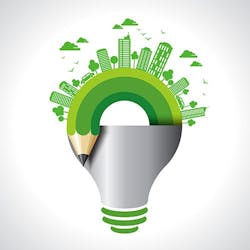Asset-Backed Demand Response: The ‘Next Big Idea’ in Energy
The NRG editorial team explores the ins and outs of asset-backed demand response — what it calls “microgrid complexity made simple.”
Those with ABDR don’t have to cut back on operations to curb use of grid power. (Photo: Shutterstock/By art4all)
Over its first 100 years, electricity improved the way we live and work by bringing light to the world. Now, once again, it’s at the heart of human progress, this time with the rise of smart cities, electric transportation and virtual communications.
This new world demands electricity — and a lot of it. For example, analysts forecast that Texas will need 30% more power if it switches to all electric vehicles. For California, electric demand would rise 50%.
As we produce more and more energy to meet new demand, it’s crucial that we consider our impact on the environment. That’s why North America is adding natural gas, solar and wind energy — resources that are both abundant and cleaner than traditional fuel sources.
But it’s not enough that our electricity be cleaner and abundant — it also must always be on. While electric service has long been reliable, today’s digital age requires hyper reliability. For a data center — the processing, storage and distribution heart of a digital economy — even a momentary power outage is costly. Longer, catastrophic outages that disable health care systems can even be deadly, as witnessed in Puerto Rico after Hurricane Maria.
Unfortunately, the grid wasn’t built for the rigors of a digital, highly electric economy — it was mostly meant for providing light or operating machines and appliances.
So how do we create the new grid we need?
Microgrids: A big idea
The answer is microgrids, a big idea in the form of small, efficient and flexible energy systems. Microgrids are particularly valuable for those that need hyper reliable power, such as hospitals, data centers, manufacturers, municipal services and the military.
What exactly is a microgrid? Think of a miniaturized version of the grid. A microgrid contains on-site generators, sometimes energy storage, inverters, switches, controls and wires. But it serves a small footprint — maybe a campus, an industrial complex or a town’s fire, water and police departments.
What really makes a microgrid a microgrid is its ability to “island.” This means it can separate from the main grid and operate independently. If a power outage occurs, the microgrid shuts off its grid connection and turns on its generators to serve customers.
Join Microgrid Knowledge and NRG Energy for a livestream discussion, “Renewables: The emerging case for businesses in Texas,” Thursday, Sept. 26, 2-3 ET.
Of course, most of the time the grid performs well. Power outages are rare. So what does the microgrid do then? Does it sit idle? Hardly.
This is where microgrids get interesting — and complex. A microgrid typically spends most of its time taking and giving energy and services to the grid, depending on what’s in its financial and operational interests at the moment.
For the grid, the microgrid can serve as an additional resource, something to draw upon when it needs extra power. That might be a hot summer day when air conditioners are all running. Or it could be a moment when a cloud covers the sun or the wind ceases to blow, and renewable energy production stops.
Asset-Backed Demand Response: An even bigger idea
Microgrids sound appealing. But most of us don’t have the time, or the expertise, to operate our own little grid.
That’s where an even newer and bigger idea comes into play. It’s called asset-backed demand response (ABDR) — microgrid complexity made simple.
From the customer’s perspective, there is nothing to do but reap the system’s benefits. ABDR is turnkey from start to finish. An energy solutions provider like NRG installs, manages and operates the system tailored to the customer’s needs. The provider can even own it, if the customer chooses.
The energy system — the ‘asset-backed’ part of the name — provides microgrid reliability. If the grid goes down, the power can stay on for an ABDR customer.
Equally important, the customer makes little or no capital investment, but instead pays only for service, creating a solution that can be both easy to implement upfront and one that creates guaranteed energy outcomes over time.
Implementation itself adds to the story. The provider manages the system within the energy market, bringing its years of commercial and technological know-how. In this way, the ABDR system becomes a financial resource. Virtually all aspects of this new integrated energy system are coordinated by the provider’s team — from design of the actual microgrid technology, management of all third-party commodity agreements, support of grid reliability, all the way down to coordination of bill management through single monthly energy payments that can deliver guaranteed savings.
As the system takes hold, its dynamic, flexible nature becomes evident. For example, at times when grid power is expensive, the system relies on its lower cost, on-site generation. Conversely, if grid power prices are lower than ABDR production, the provider will arrange for the customer to take grid power.
This kind of sophisticated management gives rise to the second part of the name: demand response.
When need for power is high, such as during a hot summer day, operators sometimes ask customers to lower their energy use to reduce stress on the grid. They pay the customers for doing so. These programs are called demand response.
Those with ABDR don’t have to cut back on operations to curb use of grid power. Instead, they switch to their on-site generators — likely natural gas — to continue their important work and at the same time receive a demand response payment.
So ABDR offers a win for everybody. The customer has a holistic energy system and predictable energy spend. Generation is on-site, yet managed with the sophistication of a grid asset. The grid has a flexible resource to call upon. And the digital age finds itself with electrical service that lives up to its quickly changing needs.
This post from NRG’s Editorial Voices team originally ran on NRG Insights.







